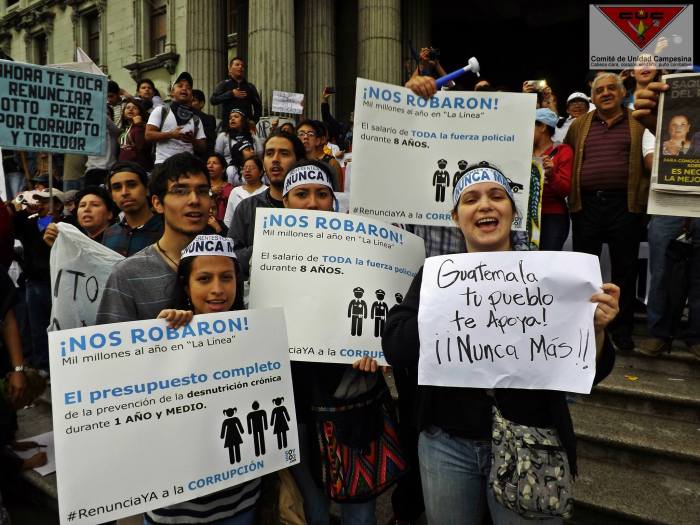By Richard Arghiris
More than 40,000 protesters swept through the streets of Guatemala City yesterday, Saturday 16 May 2015, to vent fury over the nation’s unfolding corruption scandal, which is set to become the country’s most severe political crisis since the end of the civil war in 1996.
Converging outside the National Palace, the protesters called for the resignation of President Otto Perez Molina, as well as jail time for his former Vice-President, Roxana Baldetti, who resigned last week after her former private secretary, Juan Carlos Monzón Rojas, whereabouts unknown, was implicated as a ring-leader in the infamous ‘La Linea’ crime syndicate.
The syndicate is thought to have defrauded the state of millions of dollars by accepting bribes in exchange for lowered import duties. Guatemala’s current and former tax chiefs are suspects in the scandal, which is believed to involve at least 50 private citizens and public servants.
The protests, which were staged simultaneously in several parts of the country, were not organised by any single group, but appeared to evolve organically through decentralised social media networks. It drew crowds from diverse quarters of civil society, most significantly, the middle classes.
“Given the history and on-going reality of repression and impunity in Guatemala, this is a very courageous display of citizen action,” said Grahame Russell, director of the human rights NGO Rights Action in a recent newsletter. “Repression is a very real reality in the coming days and weeks as a growing number of people overcome their fear and peacefully take to the streets to express their indignation at so many generations of corruption, exploitation, repression and impunity.”
The protest marks the end of a tumultuous week for the government, which many suspect of involvement in the scandal at the highest levels. On Monday, the Associated Press announced it had obtained recordings of wire-tapped telephone calls between businessman and fugitive Luis Mendizabal, various Guatemalan lawyers, and suspects, including some of the 27 currently in custody. Mendizabal’s boutique clothes shop, ‘Emilio’, is believed to have been a meeting place for the fraud ring.
The wiretaps mention ‘the No 2’, ‘the lady’ and ‘the R’, which prosecutors believe may be a reference to the former Vice President, who is currently not under arrest, but has been ordered not to leave the country. The Associated Press noted a conversation on April 16 where Mendizabal told detainee Javier Ortiz that he will soon be free.
“Blanca Stalling is behind it and they have very good communication,” he said.
Judge Blanca Stalling Davila, a Supreme Court justice, was quick to deny any involvement in the scandal, suggesting that perhaps Mendizabal had confused her with her sister, Judge Marta Sierra Stalling. According to prosecutors and a UN investigative commission, Judge Sierra Stalling accepted payment for the release of three suspects on bail, including Oritz. All the suspects have now been returned to custody along with the five lawyers alleged to have paid the bribe.
On Thursday 14 May, Guatemala’s congress selected a new Vice President, Alejandro Maldonado Aguirre, from three nominees submitted by President Otto Perez Molina. Maldonado was a constitutional judge, former Cabinet minister and ambassador, described by the President as an ‘exemplary Guatemalan’.
“I ask for the support from the entire country … all those who want to join the effort to bolster and deepen our democracy,” said Perez Molina.
In fact, Maldonado was one of the three judges on the country’s five-member Constitutional Court who ruled in favour of annulling the genocide conviction of dictator Efrain Rios Montt in 2013.
Against the backdrop of general elections later this year, the crisis continues…
Photo credits: Comité de Unidad Campesina (CUC)
Categories: Justice, Solidarity in Action





Post comments here